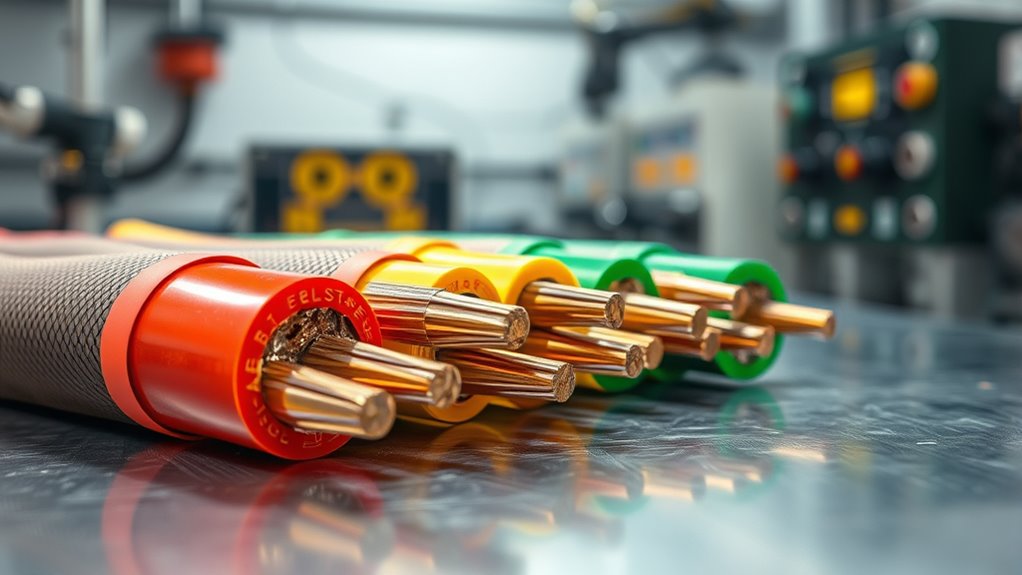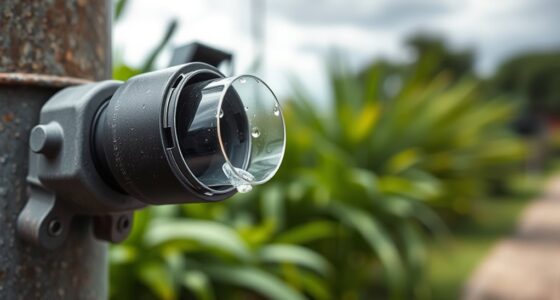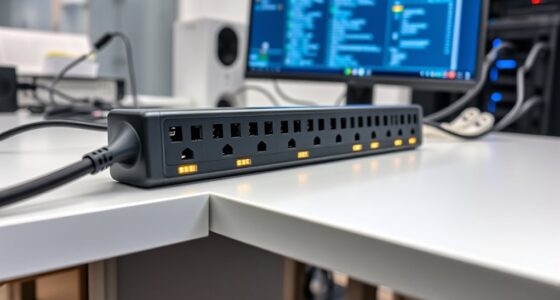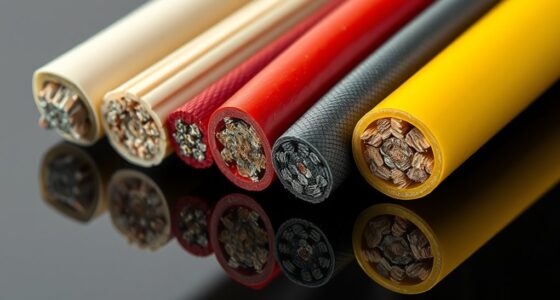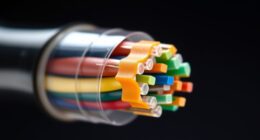Cable derating adjusts how much current a cable can safely carry based on environmental factors like temperature, humidity, and installation conditions. Temperature ratings tell you the maximum ambient temperature the insulation can handle without damage. Higher temperatures require lower current capacity to prevent overheating and damage. Proper derating and understanding these ratings make certain your cables stay safe, reliable, and perform well in different environments. Keep exploring to learn how to select and install cables correctly for your needs.
Key Takeaways
- Cable derating reduces current capacity based on environmental factors like temperature to prevent overheating.
- Insulation material and its temperature rating determine how much current a cable can safely carry.
- Higher ambient temperatures typically require derating or selecting cables with higher temperature ratings.
- Proper assessment of installation conditions ensures cables are rated correctly for safety and reliability.
- Using cables with appropriate derating and temperature ratings prevents insulation failure and electrical hazards.
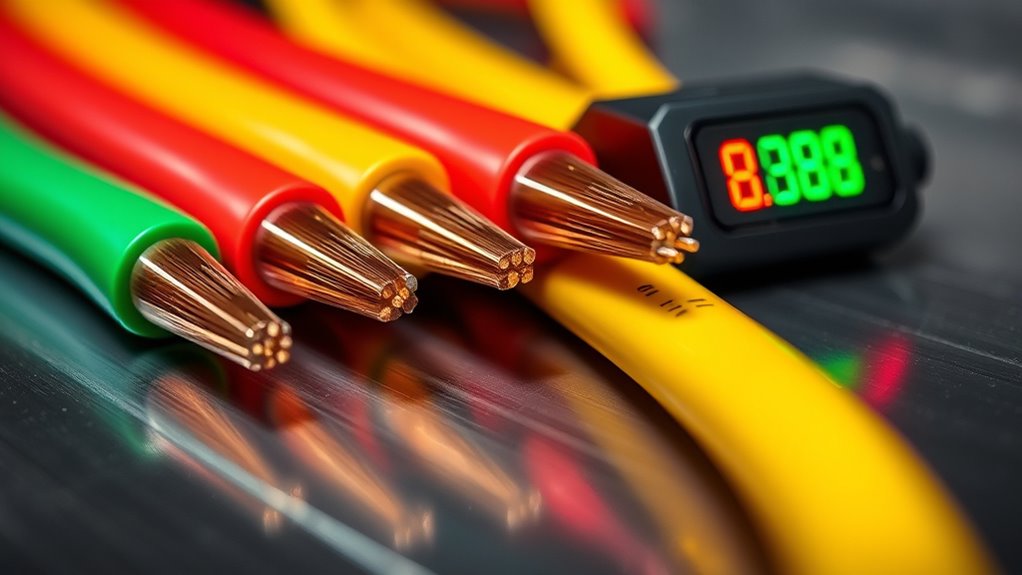
Understanding cable derating and temperature ratings is essential for ensuring safe and reliable electrical system performance. When selecting cables for a project, you need to contemplate how various factors affect their current-carrying capacity. One critical aspect is the conductor insulation, which plays a crucial role in determining how much current a cable can safely handle. The insulation material must withstand not only the electrical load but also the surrounding environment. If the ambient conditions—such as temperature, humidity, or exposure to sunlight—are harsh, they can impact the insulation’s ability to contain heat and prevent electrical faults.
Ambient conditions are a major influence on how a cable performs in real-world settings. For example, in high-temperature environments, the cable’s insulation can reach its maximum temperature limit more quickly, reducing its capacity to carry current without damage. This is where derating comes into play. Derating involves reducing the allowable current for a cable based on the environmental factors and the characteristics of its insulation. If you ignore these factors, you risk overheating the cable, which can lead to insulation breakdown, short circuits, or even fires. To prevent such hazards, manufacturers specify temperature ratings that indicate the maximum ambient temperature a cable can tolerate while maintaining its rated current.
You should also remember that conductor insulation types are designed with specific temperature ratings in mind. For instance, some insulation materials are rated for higher temperatures, meaning they can handle more heat generated by current flow in warmer conditions. When ambient conditions are cooler, you might get away with using a cable rated for a lower temperature, but if the environment is hotter, you need to select one with a higher temperature rating or apply derating calculations to determine the safe current capacity. It’s important to always verify the insulation’s temperature limits and consider the actual ambient temperature conditions at your installation site. Additionally, understanding the temperature ratings of cables helps in planning for long-term reliability and safety in various environments.
Frequently Asked Questions
How Do Ambient Conditions Affect Cable Derating Factors?
Ambient conditions directly impact cable derating factors through ambient adjustments. When environmental factors like high temperatures, humidity, or exposure to sunlight are present, they can reduce a cable’s current-carrying capacity. You need to take into account these factors, as they cause derating, meaning you might have to use a larger cable size or reduce load to ensure safety and compliance. Always evaluate ambient conditions to determine appropriate derating adjustments.
Can Cable Temperature Ratings Change Over Time?
Yes, cable temperature ratings can change over time due to aging effects and insulation degradation. As cables age, their insulation may deteriorate, reducing their ability to handle the original temperature ratings safely. This means you should regularly inspect and test cables, especially in harsh environments, to verify they remain within safe temperature limits. Proper maintenance helps prevent failures caused by insulation breakdown and aging-related temperature rating reductions.
What Are the Safety Implications of Exceeding Cable Temperature Ratings?
Exceeding cable temperature ratings risks severe safety issues. While thermal expansion might seem minor, it can cause insulation degradation over time, leading to shorts or fires. You might think cooling methods help, but persistent overheating damages the cable’s integrity. Ignoring these limits jeopardizes your safety, risking equipment failure and hazards. Always verify your cables stay within rated temperatures to prevent costly accidents and maintain a safe environment.
How Do Different Insulation Materials Influence Derating Calculations?
Different insulation materials markedly influence derating calculations because their insulation durability and material compatibility vary. When selecting cables, you need to take into account how each material responds to temperature increases; some materials tolerate higher temps without degrading, reducing derating needs. Conversely, less durable insulations require more conservative derating to prevent breakdowns. Always match insulation type with operating conditions to guarantee safety, reliability, and ideal cable performance.
Are There Industry Standards for Cable Derating Procedures?
Yes, industry standards for cable derating procedures exist to guarantee safety and reliability. Organizations like the NEC (National Electrical Code) and IEEE provide guidelines that you should follow during installation. These standards specify how to adjust current ratings based on factors like temperature, bundling, and insulation type. Adhering to these derating procedures helps prevent overheating, electrical failures, and ensures compliance with safety regulations, giving you peace of mind.
Conclusion
Think of cable derating like adjusting a recipe for altitude—you need to modify ingredients to get the best result. Just like overbaking a cake at high altitude ruins it, ignoring temperature ratings can cause your cables to fail. So, always consider derating and temperature factors when planning your wiring. Doing so guarantees your electrical setup remains reliable, much like a perfectly baked cake rises beautifully, no matter the altitude.
